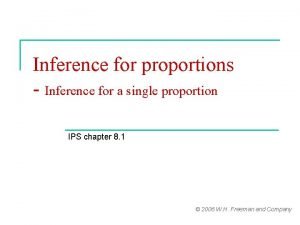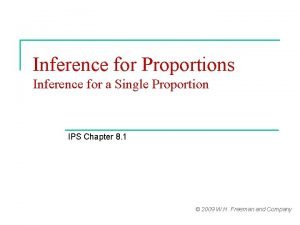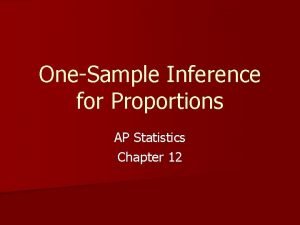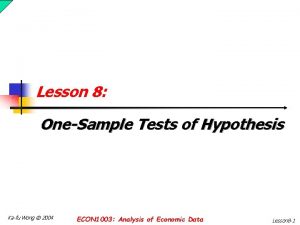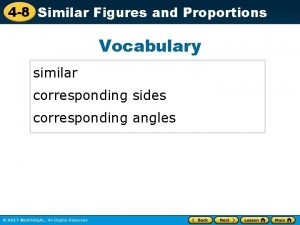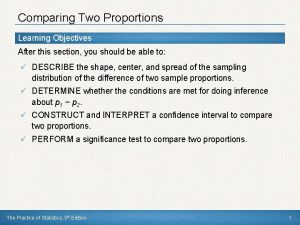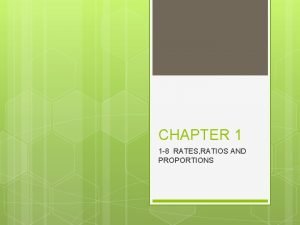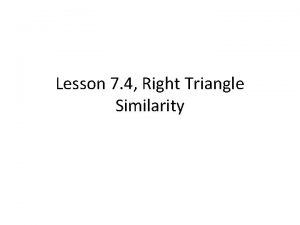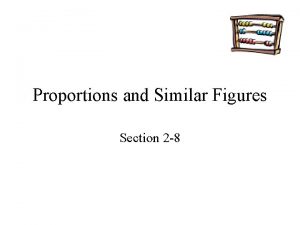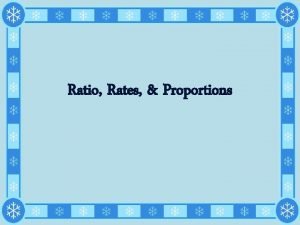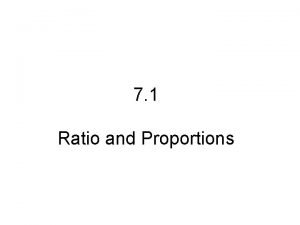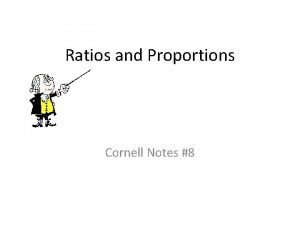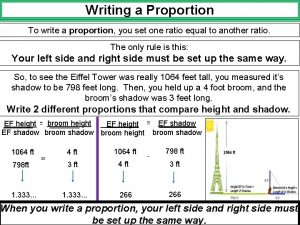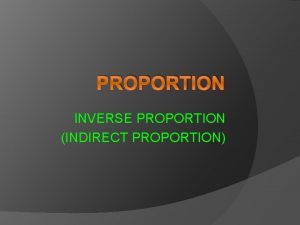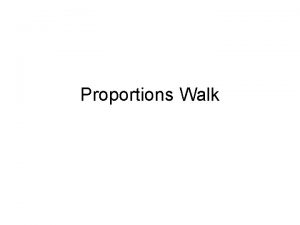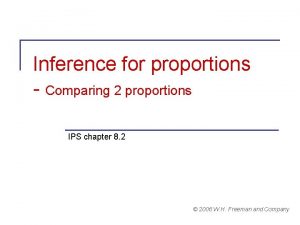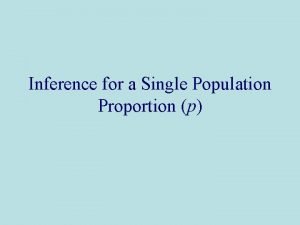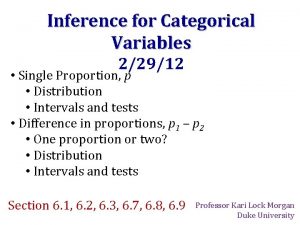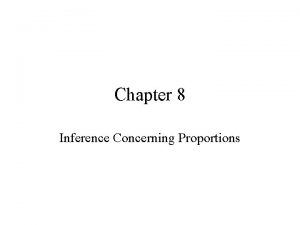Inference for proportions Inference for a single proportion


















- Slides: 18

Inference for proportions - Inference for a single proportion IPS chapter 8. 1 © 2006 W. H. Freeman and Company

Objectives (IPS chapter 8. 1) Inference for a single proportion p Conditions for inference on p p Large-sample confidence interval for p p “Plus four” confidence interval for p p Significance test for a proportion p Sample size for a desired margin of error

Sampling distribution of p^ — reminder The sampling distribution of a sample proportion is approximately normal (normal approximation of a binomial distribution) when the sample size is large enough.

Conditions for inference on p Assumptions: 1. The data used for the estimate are an SRS from the population studied. 2. The population is at least 10 times as large as the sample. This ensures that the standard deviation of the estimator is close to 3. The sample size n is large enough that the sampling distribution can be approximated with a normal distribution. How large a sample size is required depends in part on the value of p. For small samples we must rely on the binomial distribution.

Large-sample confidence interval for p intervals contain the population proportion p in C% of Confidence samples. For an SRS of size n drawn from a large population and with sample proportion calculated from the data, an approximate level C confidence interval for p is: C Use this method when the number of successes and the number of failures are both at least 15. m −Z* m Z* C is the area under the standard normal curve between −z* and z*.

Medication side effects Arthritis is a chronic inflammation of the joints. An experiment on the side effects of pain relievers examined arthritis patients to find the proportion of patients who suffer side effects. What are some side effects of ibuprofen? Serious side effects (seek medical attention immediately): Allergic reaction (difficulty breathing, swelling, or hives), Muscle cramps, numbness, or tingling, Ulcers (open sores) in the mouth, Rapid weight gain (fluid retention), Seizures, Black, bloody, or tarry stools, Blood in your urine or vomit, Decreased hearing or ringing in the ears, Jaundice (yellowing of the skin or eyes), or Abdominal cramping, indigestion, or heartburn, Less serious side effects (discuss with your doctor): Dizziness or headache, Nausea, gaseousness, diarrhea, or constipation, Depression, Fatigue or weakness, Dry mouth, or Irregular menstrual periods

Suppose 23 of 440 people who take part in an investigation suffer from one or more side effects. What is the sample proportion ? What is the sampling distribution for the proportion of arthritis patients with adverse symptoms for samples of 440? For a 90% confidence level, z* = 1. 645. Using the large sample method, we calculate a margin of error m: With a 90% confidence level we can say, between 2. 9% and 7. 5% of arthritis patients taking this medication experience some adverse side effects.

Because we have to use an estimate of p to compute the margin of error, confidence intervals for a population proportion are not very accurate. Specifically, we tend to be incorrect more often than the confidence level would indicate. But there is no systematic amount (because it depends on p). Use with caution!

“Plus four” confidence interval for p A simple adjustment produces more accurate confidence intervals. We act as if we had four additional observations, two being successes and two being failures. In this imaginary world the new sample size is n + 4 and the count of successes is X + 2. The “plus four” estimate of p is: And an approximate level C confidence interval is: Use this method when C is at least 90% and sample size is at least 10.

We now use the “plus four” method to recalculate the 90% confidence interval for the population proportion of arthritis patients who suffer from some adverse effects. What is the value of the “plus four” estimate of p? An approximate 90% confidence interval for p using the “plus four” method is: With 90% confidence level, between 3. 8% and 7. 4% of arthritis patients taking this pain medication experience some adverse effects.

Significance test for p The sampling distribution for is approximately normal for large sample sizes and its shape depends solely on p and n. Thus, we can easily test the null hypothesis: H 0: p = p 0 (some specific value). If H 0 is true, the sampling distribution is known The likelihood of our sample proportion given the null hypothesis depends on how far from p 0 our is, in standardized units. This is valid when both expected counts—expected successes np 0 and expected failures n(1 − p 0)—are each 10 or larger.

P-values and one or two sided hypotheses— reminder And as always, if the p-value is smaller than the chosen significance level a, then the difference is statistically significant and we reject H 0.

A survey by the National Institute for Occupational Safety and Health (NIOSH) of restaurant employees found that 75% said that work stress had a negative impact on their personal lives. You investigate a restaurant chain to see if the proportion of all their employees negatively affected by work stress differs from the national proportion p 0 = 0. 75. H 0: p = p 0 = 0. 75 vs. Ha: p ≠ 0. 75 (2 sided alternative) In your SRS of 100 employees, you find that 68 answered “Yes” when asked, “Does work stress have a negative impact on your personal life? ” The expected counts are 100 × 0. 75 = 75 and 25. Both are greater than 10, so we can use the z-test. The test statistic is:

From Table A we find that the area to the left of z, 1. 62, is 0. 9474. Thus P(Z ≥ 1. 62) = 1 − 0. 9474, or 0. 0526. Since the alternative hypothesis is two-sided, the P-value is the area in both tails, and P = 2 × 0. 0526 = 0. 1052. The chain restaurant data are not significantly different from the national survey results (pˆ = 0. 68, z = 1. 62, P = 0. 11).

Interpretation: magnitude vs. reliability of effects The reliability of an interpretation is related to the strength of the evidence. The smaller the p-value, the stronger the evidence against the null hypothesis and the more confident you can be about your interpretation. The magnitude or size of an effect relates to the real-life relevance of the phenomenon uncovered. The p-value does NOT assess the relevance of the effect, nor its magnitude. A confidence interval will assess the magnitude of the effect. However, magnitude is not necessarily equivalent to practical relevance.

Sample size for a desired margin of error You may need to choose a sample size large enough to achieve a specified margin of error. However, because the sampling distribution of is a function of the population proportion p, this process requires that you guess a likely value for p: p*. In a “worst case” (yielding the biggest sample size) analysis we use p=. 5 to be sure that our sample size calculation doesn’t underestimate the sample size requirements.

What sample size would we need in order to achieve a margin of error no more than 0. 01 (1%) for a 90% confidence interval for the population proportion of arthritis patients who suffer some “adverse symptoms. ” We could use 0. 5 for our guessed p*. However, we might suppose that we have data that indicates that p is somewhere in the neighborhood of 10%. (a better guess than 50%). For a 90% confidence level, z* = 1. 645. To obtain a margin of error no more than 1%, we would need a sample size n of at least 2435 arthritis patients.

In circumstances where we don’t have any reliable prior information with which to initially estimate p we often choose the worst case scenario. That is, we use p = 0. 5 in the sample size formula. The only thing that changes is that p(1 -p) =. 5(. 5) =. 25 instead of. 1(. 9) =. 09 as in the previous calculation. Since. 25 is nearly three times as large as. 09 we should expect the sample size requirement to just about triple Indeed, we get. Values of p “around” 0. 5 result in similar sample size requirements. For values of p far from 0. 5, as in this example, the calculations are far different.
 Inference for a single proportion
Inference for a single proportion Inference for a single proportion
Inference for a single proportion Chapter 12 inference for proportions answers
Chapter 12 inference for proportions answers Kafu wong
Kafu wong Example of sisd
Example of sisd Dataxin
Dataxin Multi channel multi phase example
Multi channel multi phase example Homework 1 ratio and proportion answer key
Homework 1 ratio and proportion answer key Trapezoid ratio and proportion
Trapezoid ratio and proportion Similar figure proportions
Similar figure proportions Chapter 22 comparing two proportions
Chapter 22 comparing two proportions Rates ratios and proportions
Rates ratios and proportions 7-4 similarity in right triangles
7-4 similarity in right triangles Would being part of a support group that meets regularly
Would being part of a support group that meets regularly Similar figures have the same but not necessarily the same
Similar figures have the same but not necessarily the same Is a ratio a rate
Is a ratio a rate 7-1 ratios and proportions
7-1 ratios and proportions Ratio guided notes
Ratio guided notes Ratios and proportions notes
Ratios and proportions notes
